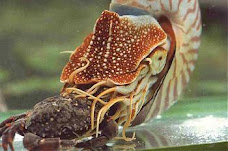Description Unlike other cephalopods, they do not have good vision nor a highly developed brain. The structure of the eyes is highly modified but renders the visual quality alike that of a pin hole camera because it lacks a solid lens. For this reason, they are thought to rely more heavily on smell (olfaction).
Phylogenetic Position: 
Cephalopoda is a large class in which the majority of sub-classes and orders are extinct except the Coleoidea subclass (neocoleoids) and the Nautiloidea subclass. Nautilina is also the only sub-order of Nautilida with any living members.
The family Nautilidae contains two genera, Nautilus and Allonautilus, and six extant species in total. The six species are:
-Nautilus belauensis (Palau nautilus) (bottom left)
-Nautilus macromphalus (bellybutton nautilus) (centre)
-Nautilus pompilius pompilius/suluensis (chambered nautilus) (bottom right)
-Nautilus stenomphalus (white-patch nautilus) (left column)
-Allonautilus perforatus
-Allonautilus scrobiculatus (top right on right)


Because more is known of Nautilus sp and Allonautilus differ usually in only gills, male reproductive strategy or shell-ribbing, I will refer to Nautilus sp. more often. Unless noted otherwise, these qualities are expected to apply to Allonautilus sp.
The shell, the same for Nautilus and Allonautilus, is formed of three layers of either organic periostracum (exterior) or calcareous aragonite crystals, is a long coil devided by septa into progressively smaller chambers, or camerae, towards the innermost chamber of the coil. This is the posterior end, and it is the oldest part of the shell, the rest of the shell was secreted with growth. In A. scrobiculatus, a thick encrusting layer of shell called periostracum is present. It is interesting to note that these shells are beautifully logarithmic with a ratio of 1: 1.618, often confused with the "Golden Ratio"
The soft body of Nautilus lives in only the most anterior region, called the body chamber. The soft body is considered everything but the shell, including all the viseral organs and the tentacles, which can be up to 90 in number! As the soft body grows and moves forward, the previous body chamber is filled with fluid, and shell is secreted to seal it except for at the siphuncle. The siphuncle is a calcareous tube enclosing a strand of tissue that is continuous throughout the shell. This allows gas to be pumped into the chambers through osmosis and gives Nautilus bouyancy as it increases in depth. Conversly, if the nautilus is climbing in depth towards to surface, it can pump fluid or gas into the chambers. Here is a diagram of all the major body parts.
Physiology, Ecology:
In order to swim, Nautilus must draw water into and out of the living chamber with the hyponome, or siphon (see left). Also known as jet propulsion! When water is inside the chamber, the siphuncle extracts salt from it and diffuses it into the blood. When water is pumped out, the siphuncle lessens the gas contained in the chamber in order to remain neutrally buoyant. The control of buoyancy in this manner limits the nautilus; they dont particularly do well in aquariums nor do they exist past depths of 800m due to the extreme hydrostatic pressure. At the end of this entry, there is a video depicting the constantly jet-propulsed burst swimming and the tendency for nautiluses to remain near the top in aquariums. Because swimming does not involve any limbs in propulsion, they attribute very little energy to it. Nautiluses are predators to fish, small shrimp and crustaceans and capture them using their the tentacles (see left). Because they swim so passively, they only require food once a month. The average lifespan for Nautiluses is irregularily high in comparison to other cephalopds at 20 years. In terms of reproduction they are iteroparous, they lay eggs (although never recorded in the wild), and are sexually dimorphic. A Nautilus sp. embryo removed from the egg is pictured on the left.
Nautiluses are predators to fish, small shrimp and crustaceans and capture them using their the tentacles (see left). Because they swim so passively, they only require food once a month. The average lifespan for Nautiluses is irregularily high in comparison to other cephalopds at 20 years. In terms of reproduction they are iteroparous, they lay eggs (although never recorded in the wild), and are sexually dimorphic. A Nautilus sp. embryo removed from the egg is pictured on the left.







No comments:
Post a Comment